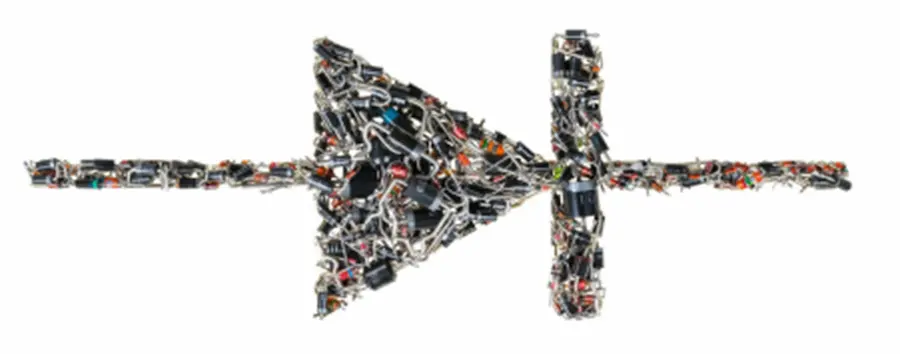Diodes are crucial components of electronics that regulate electrical current flow in most cases. An in-depth knowledge of the many types of diodes and their functions in circuits is essential for those who are enthusiastic about electronics and want to learn more about them.
In this blog, we’ll explore the basics of diodes, including their types, functionality, and common applications. Let’s get started!
Table of Contents
What are Diodes?
The conversion of alternating current (AC) to direct current (DC) and voltage regulation for circuit protection are two crucial applications of diodes in electronics. They employ semiconductors like silicon and germanium to operate at their peak efficiency.
Though the methods of conduction fluctuate throughout types, diodes essentially assist in one-way current flow. Different diode varieties each have distinct features and advantages and are tailored to particular applications.
Types of Diodes
Since each diode is meant to be used for a certain purpose, their designs vary. These are some examples of common diode types:
Zener Diodes
Electronic enthusiasts should know that the Zener diode is one special sort of diode that can function in both forward and reverse directions. It is specifically designed for voltage regulation because of its reverse bias action and heavily doped p-n junction.
Light Emitting Diode (LED)
Semiconductor LEDs emit light when power flows through them. This light is invisible in many diodes; however, due to specific frequency levels cause light to be invisible. Tricolor LEDs, which can emit three colors simultaneously, are among the several colors of LEDs that are available. Light color is determined by the energy gap of the semiconductor being used.
Schottky Diode
P-N junction diodes, known as Schottky Diodes, are specifically made for low-voltage applications, usually ranging from 0.15 to 0.4 volts. Their superior low-voltage operating characteristic makes them ideal for rectifier applications due to their unique engineering.
Rectifier Diodes
Rectifier diodes are semiconductors with two leads that permit current to flow in a singular direction. P-type and p-type semiconductor materials are typically used to generate a P-N junction diode. Alternating current (AC) is converted to direct current (DC) by a single direction of flow.
Laser Diode
Often used in CD drives, DVD players, and laser equipment, this diode is unique in that it creates coherent light. This laser source is still more cost-effective than others, even though it is more expensive than LEDs. However, these diodes’ limited lifespan is a drawback.
Avalanche Diode
Under reverse bias, this particular diode operates by utilizing the avalanche phenomenon. It breaks down when there is a continuous voltage decrease that happens regardless of current. The great sensitivity of avalanche diodes makes them an excellent option for applications requiring photodetection.
Thyristor Diodes
The three terminals of thyristor diodes, a gate, anode, and cathode, control the flow of current between the anode and cathode. By delivering a moderate current at the gate, a much higher current is enabled between the anode and cathode. When the thyristor diode is triggered, it conducts after the gate current stops. This condition is maintained until the circuit is reset.
PIN Diode
P-type, N-type, and intrinsic semiconductors make up the diode known as P-I-N. Strongly doped N-type and P-type semiconductors are placed between an intrinsic semiconducting layer (SDL). This arrangement should allow for maximum reverse voltage capability. Its intrinsic layer, with its low carrier concentration, makes the diode perfect for high-frequency operations.
Photodiode
The photodiode generates electricity in response to light energy. These particular diodes are the ones that are visible to light. Because they can detect light and operate under reverse bias conditions, they are widely employed in solar cells and photometers.
Varactor Diode
Variations in reverse voltage in the varactor diode cause variations in internal capacitance. Diodes of this type are utilized for charge storage. Semiconductor devices known as varactor diodes are voltage-dependent and constant reverse-biased devices.
Functionality of Diodes
Diodes are vital components of electronic circuits because of their numerous applications that enhance their durability and functionality. They play fundamental roles in different circuit types:
Switching Circuits (Current Steering)
When compared to traditional switches, diodes provide quicker switching speeds, prevent short circuits, and provide control over when to activate and deactivate circuits.
Varactor Circuits (Signal Demodulation)
Varactor diodes are core parts of varactor circuits because they allow automatic tuning, modulation, and control of frequency. Utilized widely in electronic tuners, parametric amplifiers, and frequency doublers, they enhance circuit performance in microwave use.
Limiter Circuits (Signal Control)
Limiter circuits often use diodes to selectively transmit signals within predefined frequency ranges, with the goal of preserving signal integrity and processing efficiency.
Regulator Circuits (Over-voltage Protection)
Zener diodes are used in circuits for voltage stability; they are produced with a high impurity content and specific manufacturing techniques. Its acute reverse breakdown features provide dependable over-voltage protection.
Common Applications of Diodes
Diodes are vital parts of semiconductor technology, available in a number of variants for a variety of purposes. Whether utilized for light absorption or photon emission, diodes find extensive usage in microscopical devices, protective circuits, rectification, power conversion, optics, sensing, and other fields. Below are some common applications of diodes:
Signal Rectification
Rectifier diodes convert rectifier AC (alternating current) to rectifier DC (direct current). Radio receivers and audio amplifiers depend on this, much like many other electronic devices do.
Voltage Regulation
Because they maintain a constant output voltage even when input voltage or load conditions vary, zener diodes are widely utilized in voltage control applications.
Lighting Systems
Lighting applications need a lot of LEDs since they are light-emitting diodes. Applications for illumination in homes, offices, and cars all make heavy use of them.
Photovoltaic Systems
A photovoltaic system’s photodiodes are necessary components for converting light energy into electrical energy. For light detection, these diodes are widely used in optical communication systems and sensors.
Final Words
Because they may be used for so many different purposes, diodes are essential parts of contemporary electronics. An enthusiast for electronics can learn more and pursue new opportunities in circuit design, power electronics, and semiconductor technology by comprehending the types, functions, and typical applications of diodes. The way that diodes produce light, regulate voltages, and correct signals has an ongoing effect on the design of electronic systems and devices.

